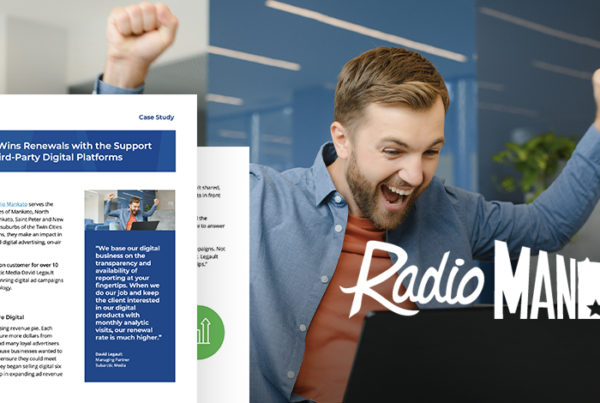What is radio’s potential for obtainable digital revenue? Answering this question and developing strategies to reach it are critical for today’s local media organizations. With radio spot advertising remaining flat or contracting, digital advertising has become a lifeline. According to the 12th annual Borrell-RAB digital benchmarking report, digital accounted for 22% of revenue in 2023.
This year’s report also included an analysis of obtainable digital dollars. Let’s review insights and tips on how to capture more local digital advertising spend.
What Is Obtainable Digital Revenue?
Obtainable digital revenue refers to the total digital advertising spent at the local level with radio, TV, print and agencies. It’s what’s left that doesn’t flow to platforms like Google, Meta, other social sites, Spotify or Pandora.
The digital benchmarking report stated that 10.2% of all local advertising remains in the market. The number for 2023 was $14.6 billion. Of note, larger obtainable digital revenue skews toward smaller markets with less competition.
How Do You Calculate Your Obtainable Digital Revenue?
The benchmarking report includes obtainable digital revenue estimates for 513 U.S. markets. The 513 areas represent those with high concentrations of digital advertising. These numbers are a baseline. You can calculate how you rank for digital revenue against small, midsize and large markets using our ROI calculator.
You can also look at your internal sales data for trends, such as closed-lost deals compared to all proposals.
Once you have a benchmark, you can build strategies to meet it.
5 Ways to Expand Your Share of Obtainable Digital Revenue
There are tremendous opportunities for local media sellers to win more local digital advertising deals. The growth of this revenue has been steady, and the Borrell-RAB report projected that it would reach $2 billion in 2024.
Here are some tips to boost your digital sales in your market.
You can offer local companies a portfolio of advertising options.
Businesses working with you may be able to manage all their advertising needs through one source. You can offer them radio, O&O (owned and operated) ads, sponsorships and digital tactics. It’s a win for all parties, as advertisers seek convenience in managing ad spending.
It also allows you to design integrated campaigns that use multiple channels to promote or relay brand messaging. An omnichannel approach drives better performance, which makes renewals that much easier.
Plus, it’s more cost-effective for advertisers. If they have multiple vendors, they may be paying high fees for “managed services,” which they won’t face with you.
You have the trust factor in your favor.
Local businesses and consumers trust radio more than any other media source. Radio also plays a pivotal role in the community. Some of your local competitors may share these advantages, but it certainly puts you ahead of most agencies.
The key to leveraging the trust factor is to make it part of your conversations. Discuss the history of the station’s involvement and commitment to local businesses. This unique strength of radio can help advertisers apprehensive about digital media be more confident in buying it.
You should discuss the rise of streaming as a local media ad tactic.
More consumers stream TV rather than watch it traditionally. This trend applies to every demographic, which means broadcast TV ads have fewer eyeballs. Additionally, streaming ads via CTV or OTT are targetable.
As a result, money is shifting from traditional TV, which may also be your digital competitor. They may be less enthusiastic about promoting streaming ads since it often means budget leaves the TV column. If your customers spend on TV, it’s worth having a conversation about the value of CTV for SMBs.
They may decide to keep some dollars for broadcast but divert others to streaming, which you can provide. You’ll gain bonus points if their ads will play on premium inventory.
You can share simple, meaningful reporting.
Most of your customers aren’t going to be digital advertising experts. However, they will always want to view their ads’ performance. Some of your competitors may provide this with little consistency. Others may deliver complicated reports that don’t mean much to businesses.
Being able to provide transparent, simple reporting can be a huge differentiator. Showing your customers sample reports and going over the basic metrics helps educate them and sets expectations.
You should prospect outside your radio demographic.
Digital advertising empowers your sellers to expand their prospecting outside your radio demographic. Anyone in your market is a good fit for digital. A few tips on how to do this include:
- Auditing your radio advertisers by industry to identify gaps
- Researching the most prevalent business types in your area
- Paying attention to the local ads you see as a consumer and adding those companies to your target list
- Focusing on company types where you have specific expertise
Get more insights by reading our e-book, 5 Easy Ways to Grow Digital Advertising!
Grow Your Share of Obtainable Digital Revenue with Marketron NXT
Employing these tactics can help you grow your digital revenue stream. What you’ll also need is a robust, easy-to-use digital advertising platform made for radio. Marketron NXT is the only solution with this designation. It integrates with your traffic platform, unifying digital and linear proposals, orders, reporting and invoicing.
Stations using NXT increased sales activity by 20% and increased order volume by an average of 76%. It’s an award-winning system designed for local media sellers.
Explore its features by requesting your demo today.






